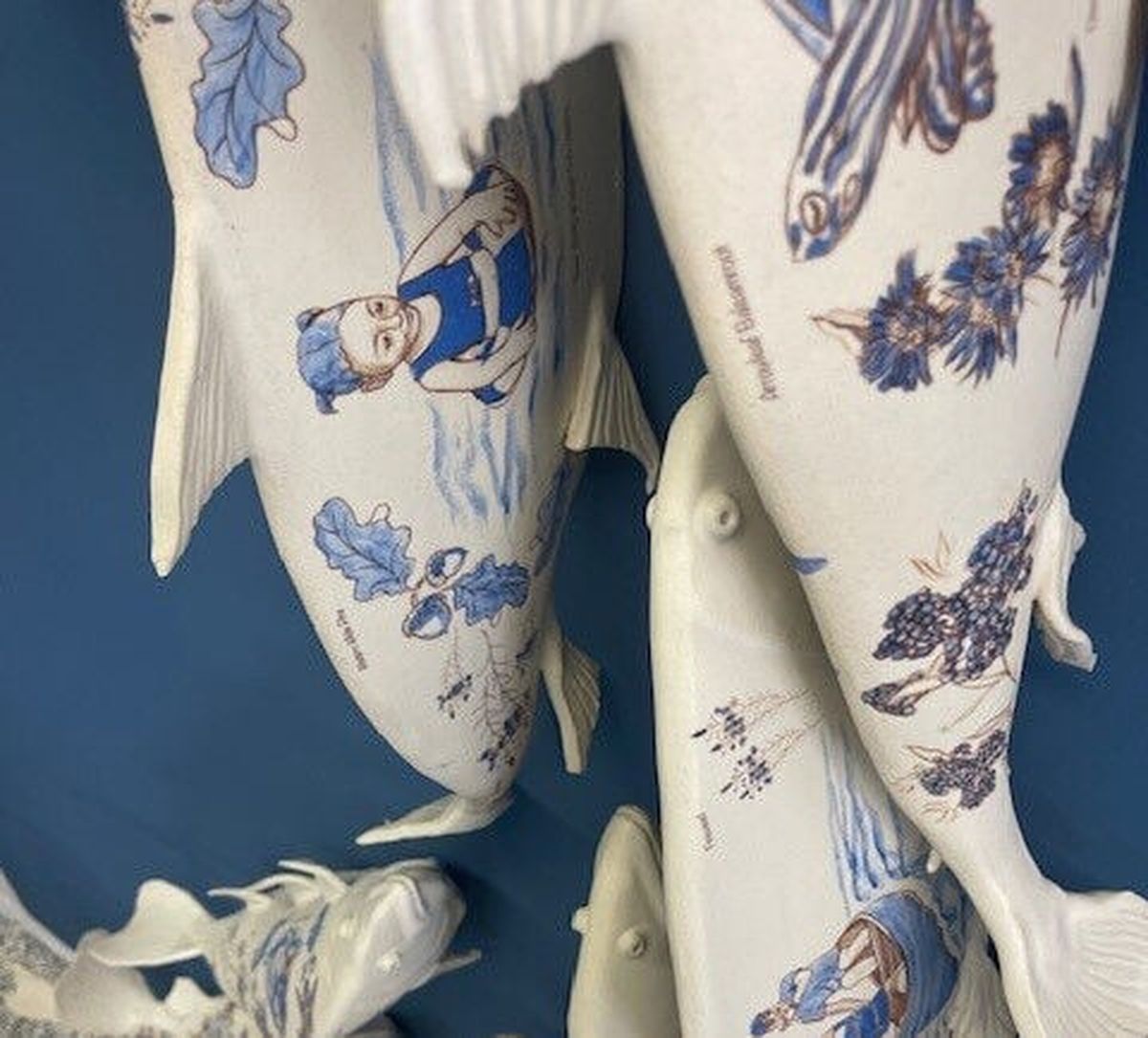Behind the scenes of Art Spirit Gallery’s ‘Veiled Notions’

Although not done in front of an audience, hanging a gallery show is like a piece of performance art.
One piece in “Veiled Notions” – the current exhibition at the Art Spirit Gallery in Coeur d’Alene – in particular required extensive choreography to display.
Mary Frances Dondelinger’s “A Love Letter to Lake Coeur d’Alene” features 45 stoneware fishes swimming through an unseen body of water. Each fish bears images representing the plants, animals and people who rely on a healthy lake.
Before the piece made its way to Art Spirit, Dondelinger, who divides her time between Coeur d’Alene and Tucson, Arizona, arranged each of the fish on a template of the gallery wall on which the piece would hang. She then marked the location of each fish on the template before hanging most of the fish on a wall in her studio in an attempt to identify any issues curator Cameron Davis might have during installation.
Dondelinger, Davis and Art Spirit Gallery owner Blair Williams then met with their respective teams to make a pre-installation game plan. On the day of the installation, a team of four fine-tuned the scaffolding setup needed for such a larger piece. They then hung the template Dondelinger created and put the numbered tacks she provided, which aligned with a corresponding fish, into precut holes.
One fish at a time, Davis replaced those tacks with the screws needed to support the fish. Once all 45 fish were in place, the team stepped back to triple-check each fish was in the right position.
The installation process took five hours. For one piece.
Courtesy of Art Spirit Gallery
“We don’t know how so many businesses or entities operate and when we can pull the curtain back and share with you the fact that we have a much deeper process and how intense it is, I think that it is intriguing,” Williams said. “I also know that there are people who potentially have interest in museum curation and entering the field and I want them to understand how intricate it can be and how exciting it can be.”
Alongside “A Love Letter to Lake Coeur d’Alene,” “Veiled Notions” also features more of Dondelinger’s stoneware work, including a series of poppy seed pod vases, and works on paper which feature egg tempera iconography.
“Veiled Notions” also features works by Helen Parsons, Susan Mattson, Randy Palmer and Chris Bivins. In a news release, “Veiled Notions” is described as a “thought-provoking art exhibit that delves into the complexities of hidden truths and unspoken narratives.”
The exhibit opened on Aug. 3. There will be an art walk on Friday and an artist talk featuring Dondelinger and Parsons on Saturday.
Spokane’s Parsons tricks the viewer’s eyes with her works on fabric, which, from afar, look like paintings.
“Textiles hint at the familiar but are easily manipulated as a means of questioning our preconceived notions,” Parsons wrote in her artist statement. “I view my investigations as a way to dissect, document and celebrate humanity while we navigate rapidly changing cultural identities. My work ultimately seeks to organize scattered thoughts and experiments and translate them into tangible experiences that echo back with new ideas.”
Parsons pieces feature cotton applique collage on decommissioned parking meter bags and other fiber art creations with threads dripping from each piece, the threads as much a piece of the work as the image .
“Helen is really a current hot commodity in our region,” Williams said. “The work itself is so awe-inspiring both because of the media and because of the pop art themes that she brings to the work, but more importantly the manner in which she puts together these materials.”
“Veiled Notions” also features a series of earthenware pots from Bozeman-raised Mattson, each topped with the head and upper body of a bird, mouse, fish or hare. The body of each pot is adorned with hundreds of what might look like scales or feathers from far away but are actually tiny skulls.
“The majority of the work she does is her conversation on her worries about overpopulation in the world, how they are driving out species,” Williams said.
In Coeur d’Alene-based artist Palmer’s work, animals are the stars. A group of vultures takes a smoke break in a tree in “Hey Gary, Can I Bum a Smoke” and two geese appear to be admiring the bright pink and orange background in “The Chattingsworths (A Young Power Couple from Northern Saskatchewan).”
Williams said Palmer, whose artistic background began with making zines, is finding his way in the art world and is building a nice audience.
Finally, Eatonville, Washington’s Bivins incorporates both natural and man-made found objects, including sticks, deer antlers and rusty nails, in his masks.
“I really enjoy seeing the artistic opportunities in disparate objects and like the challenge of combining them into a cohesive whole – the alchemy of changing one thing into another,” Bivins said in his artist statement.
The diversity in the size of the works and materials used brings it all back to the choreography of installation. Should this midsize piece share a wall with two long pieces or should it stand on its own? If these two bigger pieces go here, what pieces can be used as punctuation to give the viewer a moment to breathe? Williams said the answers to these types of questions come from simply getting started.
“Once you determine what will be that foundational piece that you’re going to build the story around, it’s amazing how quickly the story can come together,” she said.